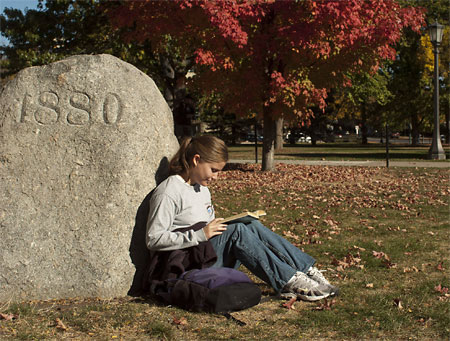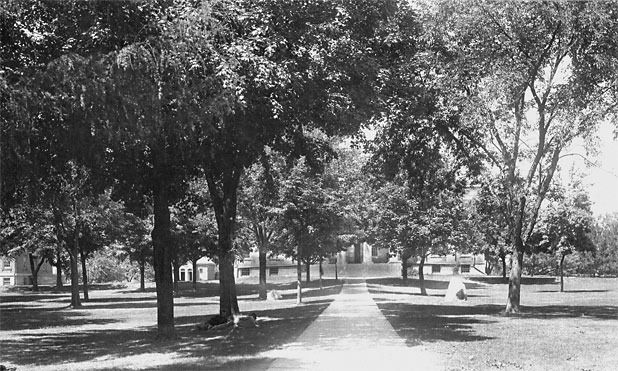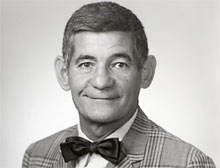-
Page Navigation Links:
- Skip to Site Navigation Links
- Skip to Features

- The University of Iowa
- Spectator
- Monthly News for UI Alumni and Friends

Ed. note: This month Old Gold yields his column to Paul Juhl, an Iowa City historian who has explored the origins of two longtime campus landmarks.
“What a strange thing is memory, and hope;
one looks backward, the other forward.
The one is today, the other is tomorrow.”
—Anna Mary Robertson Moses (Grandma Moses)
University of Iowa students have probably walked by the two boulders hundreds of times during their university studies. Some may have even braced their backs against them while resting or reading textbooks. Gardeners have mowed around them, and flowers have been placed alongside them. Some may have taken time to notice the writings on each as they hastened across to attend their classes.
The granite stone south of the sidewalk leading to the east portico of Old Capitol reads, “Class of 1870”. The one to the north reads, “Class of 1880.” Ten years apart in age, they have held their places as the Old Capitol sentinels for 142 and 132 years, respectively. Undisturbed, they have watched the campus grow from a few hundred students into today’s enrollment of more than 31,000.
Although hardly noticed, these stones do, in many ways, represent the state of Iowa. Benjamin Shambaugh mentions the stones in his 1939 book, The Old Stone Capitol Remembers, and links them to the origins of the land we now call Iowa: “Another and perhaps more dramatic scene was staged in the Iowa City region ‘when through changes of climate, Iowa was reduced to something approximating the present condition of Greenland.’ This was the time when great glaciers were formed and moved southward across the continent, ‘pulverizing the underlying rock and spreading a thick coating of loose material’ over the Iowa area. It was during the glacial period that dust storms covered the Iowa City region with a mantle of loess. The glaciers carried many boulders into Johnson County. Two of these foreign stones serve as class memorials on the campus of the State University of Iowa.”
But these stones were selected, not randomly deposited. They were chosen by members of the University of Iowa classes of 1870 and 1880 as a memorial—something to be left behind when they were graduated, something to remind those who came after that they had been there. In essence, they had left their mark.
They may have been some of the first class memorials, but they were certainly not the last. Many other classes have left behind a variety of memorials. The two that remain the most visible, however, are the boulders. The Iowa City Weekly Republican of June 13, 1870, reported:
“Around the Boulder – Thursday afternoon of Commencement week the graduating class dedicated the immense boulder, of which we before gave an account of their placing on the university grounds. There had been cut deeply upon it, ‘Class of 1870.’ J.A. Pickler made an address upon the occasion. … We trust that in future years, as the members may return and look upon this monument, they may all have from this point pursued the path of honor, duty and usefulness.”
Not to be outdone, 10 years later, the following announcement appeared in the Iowa City Daily Republican of June 17, 1880.
“The University graduating class of 1880 have secured an immense boulder from the farm of Mr. Murphy at North Liberty, which they propose to plant in the campus nearly opposite of that of 1870, as the class memorial. The rock weighs some six or seven tons, and was drawn by four pair of horses upon trucks, a distance of some ten miles. It measures more than twice the size of that of 1870. … Some criticisms are made as to the taste and policy of deforming the beauty of the campus with this species of memorial monuments, but The Republican makes none…”
But 10 years later, the Board of Regents seemed to have changed its mind regarding boulders as memorials. In the Iowa City Weekly Republican of June 25, 1890:
“The donation and dedication [is] not of a boulder, but of a fountain with thirteen jets. The dedication speech given by a Mr. Lewis later said, ‘styled the fountain a tribute of the class undying love, affection, and regard for its Alma Mater.’ … May that fountain send forth its cool, refreshing draughts, forever.”
The fountain is long gone and few can even guess where it once was. But the boulders remain, reminding us of classes long ago and their desire to leave something behind.
 Student by 1880 boulder, October 2005 [University Communication and Marketing Photographs Collection, Fall campus scenes series, Iowa Digital Library]
Student by 1880 boulder, October 2005 [University Communication and Marketing Photographs Collection, Fall campus scenes series, Iowa Digital Library]
 Old Capitol central walk, between 1886 and 1901, facing west. Boulder north of sidewalk (right) was a gift from the class of 1880. Photograph by Bertha Shambaugh [F.W. Kent Collection (RG 30.01.01), Scenes series, University of Iowa campus sub-series, University Archives, Department of Special Collections, University of Iowa Libraries]
Old Capitol central walk, between 1886 and 1901, facing west. Boulder north of sidewalk (right) was a gift from the class of 1880. Photograph by Bertha Shambaugh [F.W. Kent Collection (RG 30.01.01), Scenes series, University of Iowa campus sub-series, University Archives, Department of Special Collections, University of Iowa Libraries]
NEXT TIME:
Sam Becker:
Mr. University of Iowa
(1923-2012)

Source—F.W. Kent Collection (RG 30.01.01), Faculty series, Sam Becker folder, University Archives, Department of Special Collections, University of Iowa Libraries
If you’ve got memories to share, please send them to Spectator and we’ll run some next month.
Previous Old Gold editions:
© The University of Iowa 2009